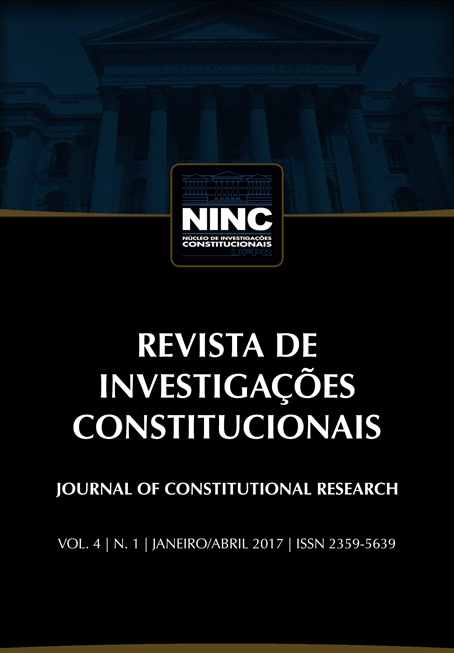The prohibition of wearing veil in public schools in Egypt: an analysis of the Egyptian Supreme Constitutional Court jurisprudence
DOI:
https://doi.org/10.5380/rinc.v4i1.50341Palavras-chave:
Case nº 8 of 1996, veil, public schools, Egypt, freedom of religionResumo
Case No.8 of 1996 is a landmark decision of the Egyptian Supreme Constitutional Court (“SCC”) and represents one of the most significant judicial rulings of a structural remedy for the interpretation of Article 2 of Egypt 2014 Constitution. The jurisprudence of the SCC is essential to advance a moderate (liberal), rights-protecting interpretation of Sharie‘a. In this case, the SCC held that a rule on face-veiling in public schools is compatible not only with Islamic law, but with certain human rights guaranteed by the Constitution:, as freedom of expression and freedom of religion. This decision dealt with the SCC’s view on Islamic ijtihad (legal reasoning), and, gives insight into the Court’s views on civil and political rights context.
Referências
‘ARAFA, Mohamed. President Mursi’s Egypt Arab Spring: Does Egypt will Continue to be a Civil State or under the Umbrella of Islamic (Sharie‘a) Law and Islamism? US-China Law Review, New York, vol. 9, n. 6, p. 1-18, dec. 2010.
‘ARAFA, Mohamed. Whither Egypt? Against Religious Fascism and Legal Authoritarianism: Pure Revolution, Popular Coup, or a Military Coup d’état? Indiana International and Comparative Law Review, Indianopolis, vol. 24, n. 4, p. 859-897, 2014.
ABOU EL-FADEL, Khaled. Conceptualizing Shari‘ah in the Modern State. Villanova Law Review, Villanova, vol. 56, n. 5, p. 803-818, 2012.
ABU-ODEH, Lama. The Politics of (Mis)recognition: Islamic Law Pedagogy in American Academia. American Journal of Comparative Law, Washington, vol. 52, p. 789-824, jan. 2004.
BROWN, Nathan; LOMBARDI, Clark. The Supreme Constitutional Court of Egypt on Islamic Law, Veiling and Civil Rights: An Annotated Translation of Supreme Constitutional Court of Egypt Case No. 8 of Judicial Year 17 (May 18, 1996). American University International Law Review, Washington, vol. 21, n. 3, p. 437-460, june 2006.
BROWN, Nathan. Islamic Constitutionalism in Theory and Practice. In: COTRAN, Eugene; SHERIF, Adel. (Eds.). Democracy, the Rule of Law and Islam. Hague: Kluwer Law International, 1999.
BROWN, Nathan; LOMBARDI, Clark. Do Constitutions Requiring Adherence to Shari‘a Threaten Human Rights? How Egypt’s Constitutional Court Reconciles Islamic Law with the Liberal Rule of Law. American University International Law Review, Washington, vol. 21, n. 3, p. 179-435, june 2006.
BROWN, Nathan. The Rule of Law in the Ancient World: Courts in Egypt and the Gulf. Cambridge: Cambridge University Press, 1997.
ELMORR Awad et al. The Supreme Constitutional Court and Its Role in the Egyptian Judicial System. In: BOYLE, Kevin; SHERIF, Adel (Eds.). Human Rights and Democracy – The Role of the Supreme Constitutional Court of Egypt. Hague: Kluwer Law International, 1996.
ELMORR, Awad. The Supreme Constitutional Court of Egypt and the Protection of Human and Political Rights. In: MALLAT, Chibli (Ed.). Islam and Public Law. [s.l.]: Springer Netherlands, 1992.
FELDMAN, Noah. After Jihad: America and the Struggle for Islamic Democracy. New York: Farrar, Straus and Giroux, 2003.
HALLAQ, Wael. A History of Islamic Legal Theories. Cambridge: Cambridge University Press, 1997.
KOPPELMAN, Andrew. Phony Originalism and the Establishment Clause. Northwestern University Law Review, Evanston, vol. 103, n. 2, p. 1-23, 2003.
LOMBARDI, Clark. Designing Islamic Constitutions: Past Trends and Options for a Democratic Future. International Journal of Constitutional Law, Washington, vol. 11, n. 3, p. 615-645, sept. 2013.
LOMBARDI, Clark. Note, Islamic Law as a Source of Constitutional Law in Egypt: The Constitutionalization of the Shari’a in a Modern Arab State. Columbia Journal of Transnational Law, New York, vol. 37, 1998.
LOMBARDI, Clark. State Law as Islamic Law in Modern Egypt. Leida: Brill Academic Publishers, 2006.
MOUFFE, Chantal. The Democratic Paradox. London: Verso, 2000.
MOUSTAFA, Tamir. Conflict and Cooperation between the State and Religious Institutions in Contemporary Egypt. International Journal of Middle East Studies, Cambridge, vol. 32, n. 1, p. 3-22, jan. 2000.
SHERIF, Adel. The Rule of Law in Egypt from a Judicial Perspective: A Digest of the Landmark Decisions of the Supreme Constitutional Court. In: CTRAN Eugene; YAMANI, Mai (Eds.). The Rule of Law in the Middle East and the Islamic World: Human Rights and the Judicial Process. London: I.B.Tauris, 2000.
ROY, Olivier. The Failure of Political Islam. Cambridge: Harvard University Press, 1994.
RUGH, Andrea. Reveal and Conceal: Dress in Contemporary Egypt. Syracuse: Syracuse University Publications in Continuing Education, 1987.
SHERIF, Adel. Constitutional Law. In: MAUGIRON Nathalie; DUPRET Baudouin (Eds.). Egypt and its Laws. London : Kluwer law international, 2002.
SULTANY, Nimer. Religion and Constitutionalism: Lessons from American and Islamic Constitutionalism. Emory International Law Review, Atlanta, vol. 28, n. 1, 345-424, 2014.
SULTANY, Nimer. The State of Progressive Constitutional Theory: The Paradox of Constitutional Democracy and the Project of Political Justification. Harvard Civil Rights-Civil Liberties Law Review, Cambridge, vol. 47, n. 2, p. 371-455, mar./june 2012.
VOGEL, Frank. Conformity with Islamic Shari’a and Constitutionality under Article 2: Some Issues of Theory, Practice, and Comparison. In: COTRAN, Eugene; SHERIF, Adel. (Eds.). Democracy, the Rule of Law and Islam. Hague: Kluwer Law International, 1999.
WEHR, Hans. A Dictionary of Modern Written Arabic [s.l.]: Milton Cowan ed., 1974.
Downloads
Publicado
Como Citar
Edição
Seção
Licença
Autores que publicam nesta revista concordam com os seguintes termos:- Autores mantém os direitos autorais e concedem à revista o direito de primeira publicação, com o trabalho simultaneamente licenciado sob a Creative Commons - Atribuição 4.0 Internacional que permite o compartilhamento do trabalho com reconhecimento da autoria e publicação inicial nesta revista.
- Autores têm autorização para assumir contratos adicionais separadamente, para distribuição não-exclusiva da versão do trabalho publicada nesta revista (ex.: publicar em repositório institucional ou como capítulo de livro), com reconhecimento de autoria e publicação inicial nesta revista.
- Autores têm permissão e são estimulados a publicar e distribuir seu trabalho online (ex.: em repositórios institucionais ou na sua página pessoal) a qualquer ponto antes ou durante o processo editorial, já que isso pode gerar alterações produtivas, bem como aumentar o impacto e a citação do trabalho publicado (Veja O Efeito do Acesso Livre).
























